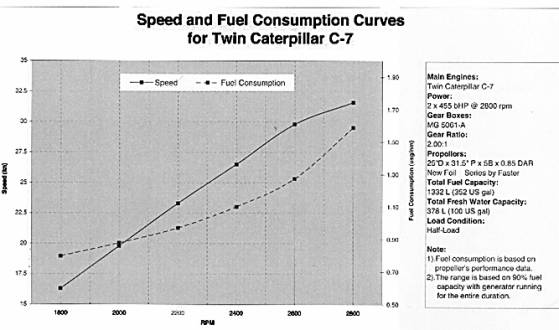 What does all this mean?
Pick your boat, pick your engine, they will all get you from point A to point B, but in what time frame, what comfort, what ability to carry passengers and supplies and what complexity of operation. This is a matter of personal choice, but it appears that the slower boats are more fuel efficient. In the Eastbay class, the Eastbay 38′ with Cat 3126TA (420 HP) comes close to the fuel efficiency of the Heritage class.
What does all this mean?
Pick your boat, pick your engine, they will all get you from point A to point B, but in what time frame, what comfort, what ability to carry passengers and supplies and what complexity of operation. This is a matter of personal choice, but it appears that the slower boats are more fuel efficient. In the Eastbay class, the Eastbay 38′ with Cat 3126TA (420 HP) comes close to the fuel efficiency of the Heritage class.
Eastbay Fuel Burn
This information got lost on the site somehow so I have moved it here where it can be easily found.
FUEL BURN DISCUSSION
The report regarding fuel consumption for 38′ Eastbay “Another Way to Look at Fuel Cost” recently posted on the OYA web-site prompted the beginning of a useful and interesting e-mail dialog that will become the basis of a forum for any and all to add their comments and views:
“Geoff:
I read the article you wrote for the OYA website on the 38” Eastbay with a pair of Cat 3208TA’s and was wondering if you have comparison data for the same model boat with 3126TA’s? I am sure the 3126’s use less fuel at the same RPM, but I am not sure what RPM it takes to produce the same speed as the 3208’s. If you have any speed/RPM data with the 3126TA’s I would like to see it. I thought the conclusion was very interesting. Thanks
Mike Negley
Mike,
Sorry, I don’t have that information but could if John would let us take one of his 38s with those engines out for some fuel runs, perhaps this Spring. Thanks for your comments. Geoff Holmes
Hey guys we will take the boat out in not too many weeks for trial runs with the mock up hardtop to get photos and we can do a little fuel testing at the same time. The 38/81 has more efficient engines as they are 3126 mechanical engines at 420 hp which should give a lower fuel consumption at a slightly elevated speed vs. 3208TA. I wouldn’t be surprised if the 3208 engine did a little better from just plaining at 9 knots to about 16 knots owing to the torque curve. Of course these conclusions are for the boat as a vinyl top. The weight of the hardtop assembly to the back of the cockpit is going to possibly change the results. In terms of our blue Awlgripped boat with the TNT lift system and fish boat hardtop with 3208TA’s and 500 hours I already reduced the prop pitch to compensate for the TNT lift and the hard top system. As a result of this the fuel curve could be a little less than EB38-81, the boat in the article.
John Shannahan
Geoff:
I have written Rob Livingston for the fuel consumption/speed data, but as yet no reply. I did search the archives on the old OYA Board and Fred Muller has a lot of data on his 36′ Classic with twin Lehman 120’s which would be a normal comparison to the 38 Eastbay and even then some would say that from an accommodations standpoint the Eastbay is a poor second.
A GB 36 Classic with twin Lehman 120 HP engines will typically cruise at 8 knots running about 1,775 RPM and uses 4.0 GPH or 0.5 gallons per nautical mile which is 32 gallons less per 100 nautical miles traveled than the 38′ Eastbay you wrote about at 2,000 RPM running 17.2 knots burning 14.11 GPH (.82 G/NM). The C-7’s would use about 0.65 G/NM running 1,800 RPM based upon Grand Banks material from the Miami Boat Show and this includes 100% generator time so the C-7 must be very close to the old Lehmans.
I think with the C-7 it is valid to say the Eastbay will travel twice as far in one day and therefore save half the dockage fees IF the 36′ Classic owner also used a marina every night. I think it is also fair to say that the Eastbay will handle light to moderate seas (I have never ridden in one!) better than the 36’Classic and with less water over the bridge. In fact, I assume the whole issue of stabilizers goes out the window with the Eastbay (that’s $30,000 less out-of-pocket). I am reluctant to say less draft (shallower water) knowing the Eastbay’s props are below the keel so I have to add back a set of spare props. Since the Eastbay has so little interior room there has to be a huge savings in “add-on’s” because there is no place to put the stuff most of us probably didn’t need anyway.
Here are some other fuel/speed numbers from the OYA archives:
* GB-42 with twin Cat 3208 Naturals (210 HP): 10 knots, 9.6 GPH
* GB-42 with twin 120 Lehman’s; 8.2 – 8.5 knots: 1,825 RPM, 4 GPH
* GB-42 with twin Cummins 210 HP: 8.8 knots, 1700-1800 RPM, 4.4 GPH
* GB-42 with twin John Deere 135s: 8.8 knots, 4.4 GPH
Mike
John
Here are a few more points on this subject. The latest version of the C-7 is the ACERT, but the fuel consumption is the same as the C-7 and I think the C-7 is the same as the 3126B.
Mike
Prop Demand numbers for the C-7 are as follows:
RPM HP GPH RPM HP GPH
1200 36 2.5 2200 220 11.3
1400 57 3.4 2400 286 14.5
1600 85 4.8 2600 364 19.0
1800 121 6.5 2800 455 25.1
2000 166 8.7
Grand Banks’ data was based on two engines and shows 2000 RPM producing just under 20 knots and the fuel consumption at just under 0.9 gallons per nautical mile so a little under 0.45 gallons per nautical mile per engine which appears to follow Cat’s prop demand numbers if we assume 2000 RPM produces 19.5 knots and 0.425 GPNM (19.5 X .425) = 8.29 GPH. This power output is using about 58% of the available HP assuming 2400 RPM is the maximum continuous duty rating. By comparison, my 3116TA’s consume 4.5 GPH (each) at 1850 RPM, but I am only moving at 9 knots and pushing 40,000 pounds.
I can tell you more than you want to know on the 3116TA’s, but fortunately the 300HP version was relatively trouble free and has performed flawlessly in my boat and is very economical.
Mike
There is a wealth of information regarding fuel economy and use that can be found in published new boat reviews a dealer specifications. The problem in many cases is the lack of uniformity in the presentation of the information and the bulk of data presented. The following table distils the data to a uniform indicator of efficiency which is a calculated value showing the number of nautical miles made per gallon of fuel consumed. Also shown is the speed achieved at a common cruising RPM. All boats shown have twin engines except for those noted with a (*).
An example of Speed and Fuel Consumption Curves for the Eastbay 39SX with twin Caterpillar C7 engines is shown below:
 What does all this mean?
Pick your boat, pick your engine, they will all get you from point A to point B, but in what time frame, what comfort, what ability to carry passengers and supplies and what complexity of operation. This is a matter of personal choice, but it appears that the slower boats are more fuel efficient. In the Eastbay class, the Eastbay 38′ with Cat 3126TA (420 HP) comes close to the fuel efficiency of the Heritage class.
What does all this mean?
Pick your boat, pick your engine, they will all get you from point A to point B, but in what time frame, what comfort, what ability to carry passengers and supplies and what complexity of operation. This is a matter of personal choice, but it appears that the slower boats are more fuel efficient. In the Eastbay class, the Eastbay 38′ with Cat 3126TA (420 HP) comes close to the fuel efficiency of the Heritage class.
 What does all this mean?
Pick your boat, pick your engine, they will all get you from point A to point B, but in what time frame, what comfort, what ability to carry passengers and supplies and what complexity of operation. This is a matter of personal choice, but it appears that the slower boats are more fuel efficient. In the Eastbay class, the Eastbay 38′ with Cat 3126TA (420 HP) comes close to the fuel efficiency of the Heritage class.
What does all this mean?
Pick your boat, pick your engine, they will all get you from point A to point B, but in what time frame, what comfort, what ability to carry passengers and supplies and what complexity of operation. This is a matter of personal choice, but it appears that the slower boats are more fuel efficient. In the Eastbay class, the Eastbay 38′ with Cat 3126TA (420 HP) comes close to the fuel efficiency of the Heritage class.

